Go to Spain bird tour page | European bird tours | European trip reports | All our birding tours
26 AUGUST – 5 SEPTEMBER 2022
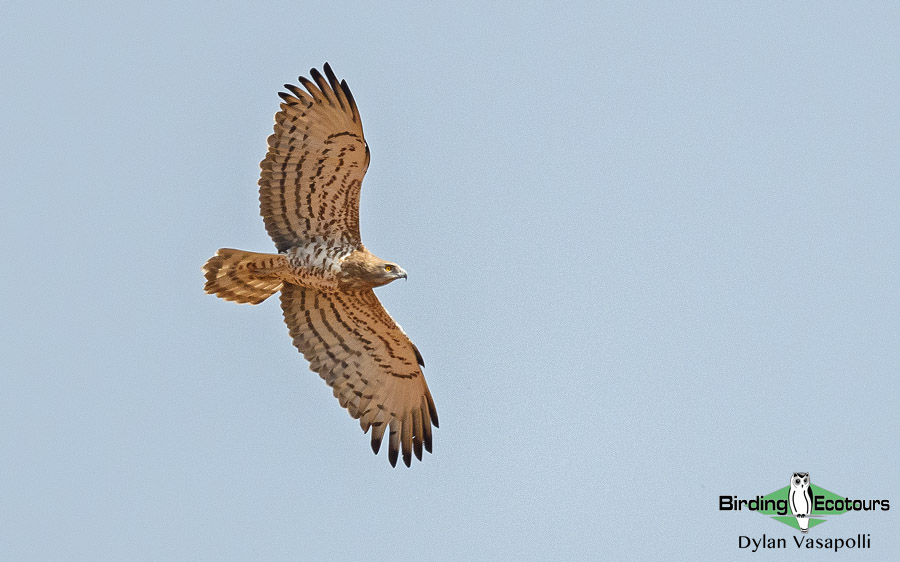 Raptor migration was one of the highlights of this tour – with Short-toed Snake Eagle seen overhead near Tarifa.
Raptor migration was one of the highlights of this tour – with Short-toed Snake Eagle seen overhead near Tarifa.
Overview
Our 11-day tour of southern Spain began on the 26th of August 2022 in the ancient city of Seville and concluded on the 5th of September in Malaga. During the tour we visited many wonderful birding locations including Brazo del Este, Bonanza Saltpans, La Janda, Barbate Marshes, Migration Observatories in the Strait of Gibraltar, Sierra de la Plata, Los Alcornocales Natural Park, Grazalema Natural Park, and the charming town of Ronda. We also took a pelagic trip in the Gulf of Cadiz and a whale watching trip off Tarifa.
Our trip around the southern part of the country gave us a list of 184 species, all of them seen and most of them seen well. The list included some sought-after birds like Northern Bald Ibis, Marbled Duck, White-headed Duck, Balearic Shearwater, Audouin’s Gull, Iberian Green Woodpecker, Iberian Grey Shrike, Mediterranean Short-toed Lark, Iberian Chiffchaff, Black Wheatear, and Rufous-tailed Scrub Robin. We also saw 19 species of raptors, some of them in high or very high numbers. These included Egyptian Vulture, Spanish Imperial Eagle, Montagu’s Harrier, and Lanner Falcon. We also enjoyed species that are of interest to Western Palearctic listers because they are regionally localized, such as Black-winged Kite, Red-knobbed Coot, Laughing Dove and Little Swift. We had mixed feelings about finding Europe’s last individual Common Bulbul. We did love being in the range of some of Europe’s most gorgeous birds such as European Roller, European Bee-eater and Eurasian Hoopoe. The full species lists are at the end of this report.
This was a very enjoyable tour, with fantastic weather, many highlights, beautiful moments, and splendid birds!

Detailed Report
Day 1, 26th August 2022. Arrival in Seville
This was the arrival day for the small group of tour participants. We went over the fundamentals of our trip during dinner at our hotel in Seville and answered any questions the participants had.
Day 2, 27th August 2022. Birding Brazo del Este, Los Palacios, and around Jerez
During our first day of birding, we visited some of the best bird-watching sites in Seville province: El Pantano and Brazo del Este. El Pantano was good for a general introduction to the birds of southern Spain. We had our first European Turtle Dove, Pallid Swift, Eurasian Hoopoe and European Bee-eater, for instance. However, the main reason for visiting this site was to look for Laughing Dove, a bird almost absent in Europe but that has been present here for the last few years. The presence of young birds accompanied by adults indicated breeding. After some short searching in the area, we had a fast view of a flying bird, and shortly afterwards we could see one more, perching briefly on a fence. Other nice birds in the area were Eurasian Penduline-Tit, Red-rumped Swallow, Western Bonelli’s Warbler and European Pied Flycatcher.
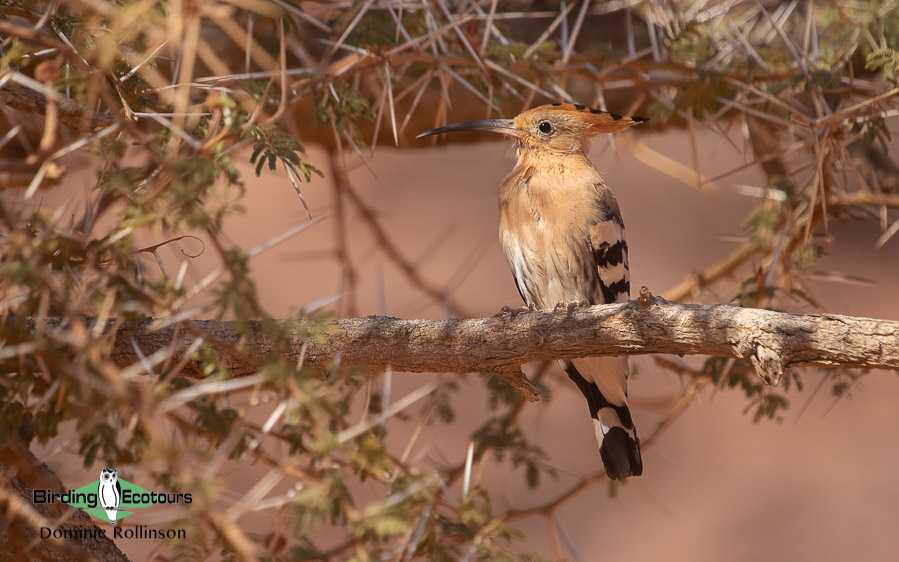
Next, we visited Brazo del Este, a great birding location, which normally brings good numbers of species as well as abundance of each species. It didn’t disappoint! We had our first Greater Flamingo of the trip, together with a good variety of shorebirds: Black-winged Stilt, Pied Avocet, Ruff, Curlew Sandpiper and Wood Sandpiper among them. We were also happy to see some Collared Pratincole, as they are less predictable during this time of the year while they are on migration or preparing to head to Africa. Even more exciting was to find Marbled Teal, a species that is on the Critically Endangered bird list for Spain and is Near Threatened with extinction globally (Birdlife International). In total we spotted 15 birds, including some ducklings. With less than 100 pairs in the country, this was quite an amazing total.
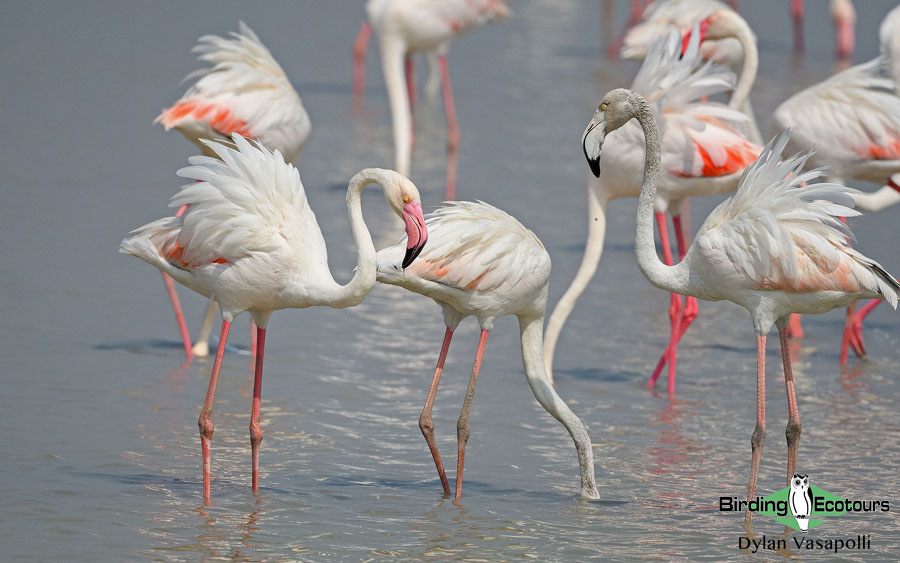
Other favorites included some of the introduced birds in the country, like Yellow-crowned Bishop, which, despite being a non-native bird, is appealing due to its spectacular bright black and yellow plumage. Other naturalized species here were Black-headed Weaver and Common Waxbill.
It’s worth mentioning that despite the high temperatures that were suffocating southern Europe during those days, and how hot this region can be, we had a soft breeze from the west that cooled the air and made our morning quite pleasant.
After our first intensive, bird-rich morning, we had a good lunch in a local restaurant before driving to Jerez where we would be staying for the following two nights. After some rest at the hotel, we visited some fields near Jerez with one main target, Rufous-tailed Scrub-Robin. The end of August can be a difficult time to find these birds, as the young are already dispersing, and some individuals could have started their migration. Nevertheless, we made our attempt and succeeded! First, we heard one distant bird calling, and after some persistence got to see not one but two birds, an adult and a juvenile. We had some more birds here, including our first Woodchat Shrike and a good number of Red-legged Partridge.
Day 3, 28th August 2022. Chipiona and Sanlucar de Barrameda
In the early morning we visited Playa de Montijo, where we took a nice walk along the beach and across the shallows. This area was packed with shorebirds (waders), including Eurasian Oystercatcher, Kentish Plover, Whimbrel, Eurasian Curlew, Bar-tailed Godwit, Sanderling, and many others. Also present were a good number of terns, including Little Tern, Caspian Tern, Black Tern, Common Tern, and Sandwich Tern. Here we also had our first Slender-billed Gull of the day together with Mediterranean Gull. We then continued with a visit to Europe’s only Little Swift breeding colony. We enjoyed amazing views of these stunning birds while we refueled with some good coffee!
After this nice morning we headed north to the Lagunas de Camino Colorado. This proved fruitful with great views of White-headed Duck, more Marbled Teal, an unexpected Tufted Duck, Red-knobbed Coot, two Temminck’s Stint, and up to three Squacco Heron. All in all, a good stop. Next we headed to a nice picnic area where we saw our first Short-toed Treecreeper and some Black Kite flying overhead. Next, we went to the nearby Bonanza saltpans, where aside from some more shorebirds (waders), we had great views of Mediterranean Short-toed Lark, our main target at this site.
Later in the afternoon we visited some open fields in search of Spanish Imperial Eagle. We didn’t find any, but in exchange we got our first Short-toed Snake-Eagle, Montagu’s Harrier and Lesser Kestrel. Then it was time to call it a day and we headed to the hotel just in time to prepare for dinner and then rest for our next day.
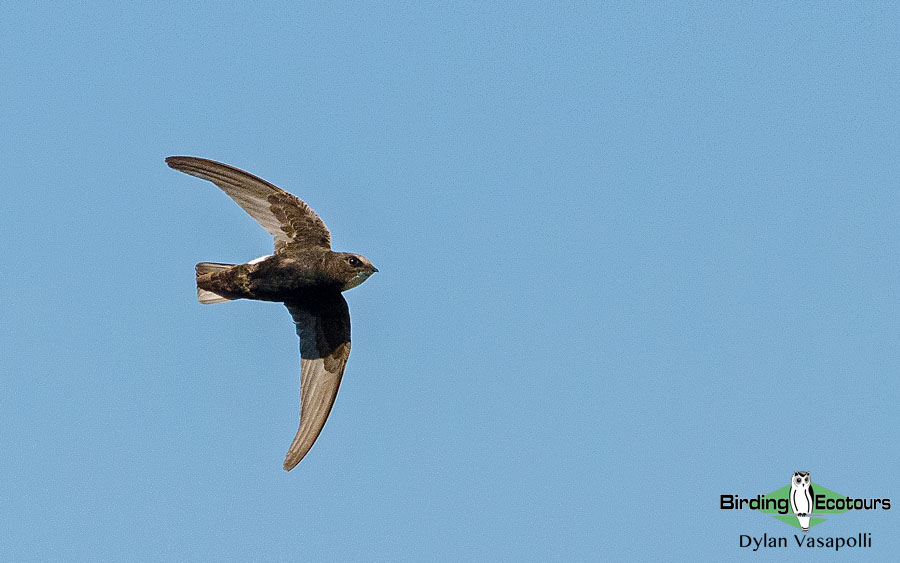
Day 4, 29th August 2022. Pelagic trip in the Gulf of Cadiz and drive to Tarifa
Today was to be a truly special day. We started by joining a pelagic trip in the Gulf of Cadiz with ten other birders. It was not long before we had our first Arctic Skua (Parasitic Jaeger) and a few Balearic Shearwater, a species that is globally Critically Endangered (Birdlife International). Some other species seen on this trip were Great Skua, Audouin’s Gull, Black Tern, Cory’s Shearwater, Manx Shearwater (very uncommon in these waters) and Northern Gannet. Our six hours spent on the boat really flew by.
Following the pelagic we had one of the best meals of the trip, consisting of a fantastic paella and fresh fish. We then went back to the hotel to pick up our luggage and started driving to Tarifa. We had time to stop on the way and try for White-rumped Swift. We spent a bit of time at a strategic location in the Cork Forest of the Los Alcornocales Natural Park but alas the swift didn’t show. However, we did bag ourselves a stunning European Roller which perched on a wire for us to see comfortably with the scope. European Roller can be very unpredictable on migration, so this was a nice addition to our list. We also enjoyed our first Alpine Swift of the trip as well as some European Honey-Buzzard, Griffon Vulture, and Booted Eagle. After this brief, but productive stop we continued to our hotel near Tarifa where we would stay for the next four days.
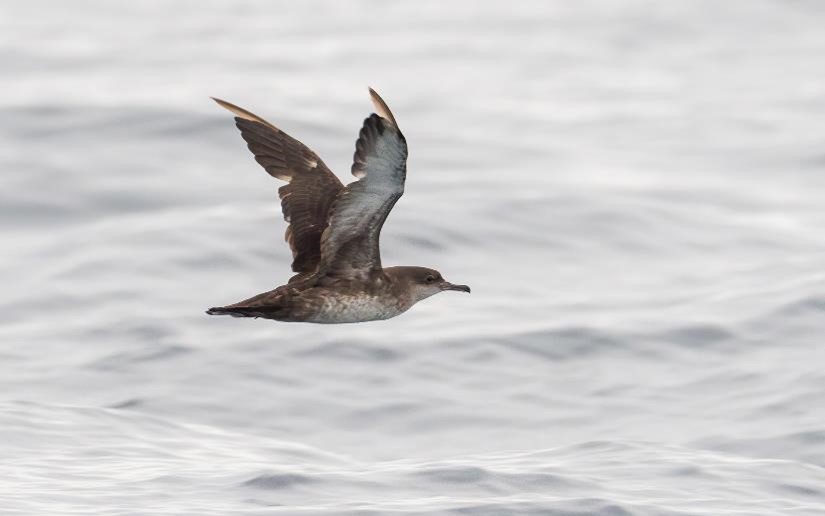
Day 5, 30th August 2022. Los Lances, Migration Observatory and Sierra de la Plata
Our first day in Tarifa started with a bang. After breakfast we observed hundreds of Black Kite sitting on the ground and in nearby trees. These birds had spent the night roosting here and were waiting for the heat of the day to build which would allow them to cross to Africa. This amazing roosting spot was less than ten minutes from our hotel and made for a great way to start the day. The first European Bee-eater were also calling insistently on their way south.
Next we decided to take a walk through Los Lances Nature Reserve. Here, good numbers of shorebirds (waders) roamed the coastal lagoon, mostly Dunlin and Sanderling. We also had the first sign of active migration, with a few European Honey-buzzard, Short-toed Snake-Eagle and Eurasian Sparrowhawk flying low above the beach, and more passing European Bee-eater too.
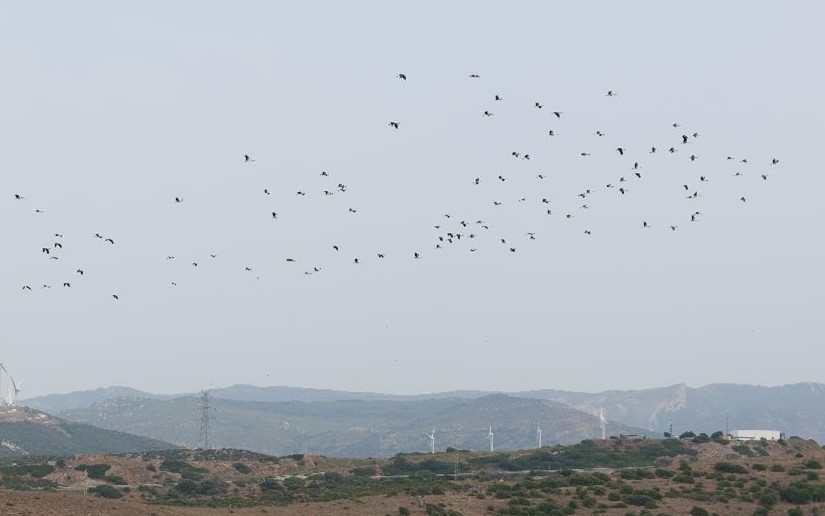
Our final bird here was the diminutive Greater Short-toed Lark, which gave great scope views. We decided it was time to head to one of the migration observatories, the prime location for amazing views of the Strait and the Moroccan coast on the other side.
It was a phenomenal experience with more than a thousand White Stork, hundreds of Short-toed Snake-Eagle, Black Kite and Booted Eagle, dozens of European Honey-Buzzard, and about twenty Egyptian Vulture, among other birds. They put on quite the show as they flew above us. Not only raptors were seen here, but nice passerines like Western Black-eared Wheatear and Tawny Pipit were also seen well. Moreover, while watching raptors flying above the Strait, a blow was seen out in the open waters: a Sperm Whale! The shape and direction of the blow was unmistakable, as well as the absence of a dorsal fin but a hump instead. These two hours were some of the best of the whole trip and things didn’t stop there. After this excellent migration session, we headed to a nearby restaurant for lunch, and a silhouette sitting on a power pylon caught our attention. Initially thought to be a Peregrine Falcon, good scope views gave us the clear features of a Lanner Falcon, a rare bird in Spain! Even though Lanner Falcon are occasionally glimpsed near Tarifa, having them sitting in one spot is an unlikely event.
After lunch we went to another striking area, Sierra de la Plata. Our first target here was Thekla’s Lark and we saw four almost immediately, spending some time comparing its features to the more commonly seen Crested Lark. We then continued to the low mountains, where we had close views of Griffon Vulture, including an adult feeding a juvenile, and some other migrating raptors like Osprey, Western Marsh Harrier, and Montagu’s Harrier.
Here we also heard our first Iberian Green Woodpecker and Great Spotted Woodpecker plus a stunning male Blue Rock Thrush was our first of the trip. However, we had to work a bit harder to see Dartford Warblerand with a bit of persistence we got to see them well, although briefly. It had been another great day and we started to head back to our hotel where we had time to freshen up before dinner.
Day 6, 31st August 2022. La Janda and Barbate marshes
Today we would dedicate our time to explore the famous area of La Janda and the Barbate Marshes. We started the morning in one of the easternmost sections of La Janda, which can be particularly good for raptors. Here we found several roosting European Honey-buzzard, a couple of Short-toed Snake-Eagle plus both Western Marsh Harrier and Montagu’s Harrier. Some new birds for us consisted of Calandra Lark and a nice late observation of Common Nightingale (a species which is difficult to see in late August). A bit further along the track we looked for Spanish Imperial Eagle and, just as we were about to leave, a juvenile showed up and could be seen flying both with binoculars and the scope. Shortly after that, an immature Bonelli’s Eagle was seen, although briefly. We then ended the morning with a roosting Red-necked Nightjar.
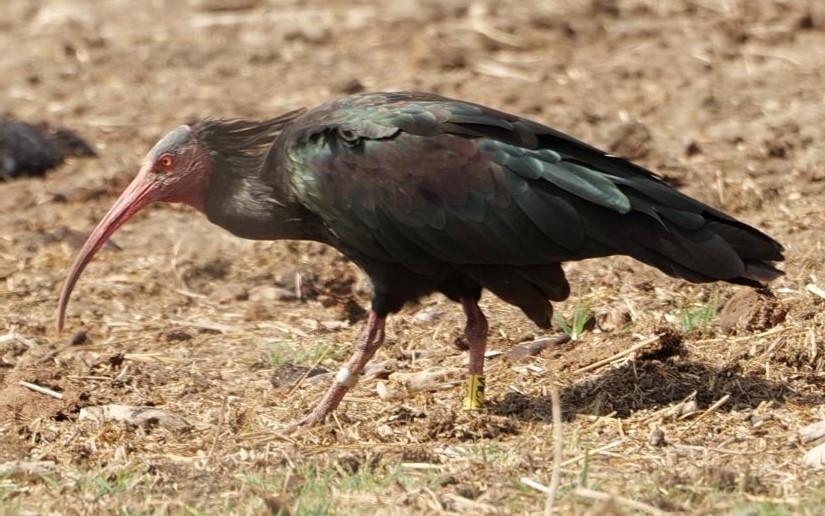
After a nice lunch we drove west in search of Northern Bald Ibis. These big birds can be a bit difficult to find out of the breeding season as they move throughout an extensive area. Indeed, we drove for quite some time around the pine forest and the marshes of Barbate with no sign of them.
However, in the very last spot we looked, we found them! Up to 15 birds were feeding and resting and could be seen at close range. Later in the marshes we added more species: Black-tailed Godwit, Gull-billed Tern, and a nice small flock of Eurasian Stone Curlew. On the way back to the hotel, we tried for Little Owl at a known spot. It took us just a bit of time before three birds made an appearance, giving us close and prolonged views.
Day 7, 1st September 2022. Benalup and whale watching trip
We had another full day in the surroundings of Tarifa, including a whale watching trip in the afternoon, so we dedicated a very still and peaceful morning to look for some birds that we were missing, like Little Bustard and Black-winged Kite.
While looking for the kite, we had a fantastic encounter with an adult Spanish Imperial Eagle, sitting on a pylon at a relatively close distance and we enjoyed prolonged views in the scope. We then continued and, after a few kilometers of driving along a dirt track, found a hunting Black-winged Kite. We were able to enjoy watching it successfully catch its prey and start to feed in front of us, giving excellent scope views.
Unfortunately, we weren’t so successful with the Little Bustard. This species is suffering a steep decline in the Iberian Peninsula, and it seems that the Strait of Gibraltar is no exception as they are becoming more and more difficult to find. In exchange we had even more raptors, including an immature Spanish Imperial Eagle, several Booted and Short-toed Eagle, Montagu’s Harrier, a new one for the trip, Red Kite. We also saw some Northern Wheatear on migration.
After a brief stop back at the hotel to get ready for the whale watching trip, we drove to the port of Tarifa and boarded the boat. We had two hours at sea, again in very good conditions. One of the highlights was being able to compare, close-up and with photos we were able to get, two “sister” species, the extremely similar Cory’s, and Scopoli’s Shearwaters. (We also enjoyed seeing Balearic Shearwater.)
In terms of sea mammals, we had excellent views of Long-finned Pilot Whale, with a large pod surrounding our boat and posing for pictures and videos, and a small group of Bottlenose Dolphin. Other remarkable observations were of Oceanic Sunfish and Bluefin Tuna.
After the whale watching trip we took a short walk around the old town of Tarifa and its castle. Here we saw a male Lesser Kestrel and, after some searching, got a good view of the only Common Bulbul in Tarifa – and probably in continental Europe! This is the last individual, as far as we know, of the offspring of a pair that bred for two consecutive years in 2014 and 2015.
We ended this long, productive day with a superb meal in the old town of Tarifa accompanied by an equally excellent wine.
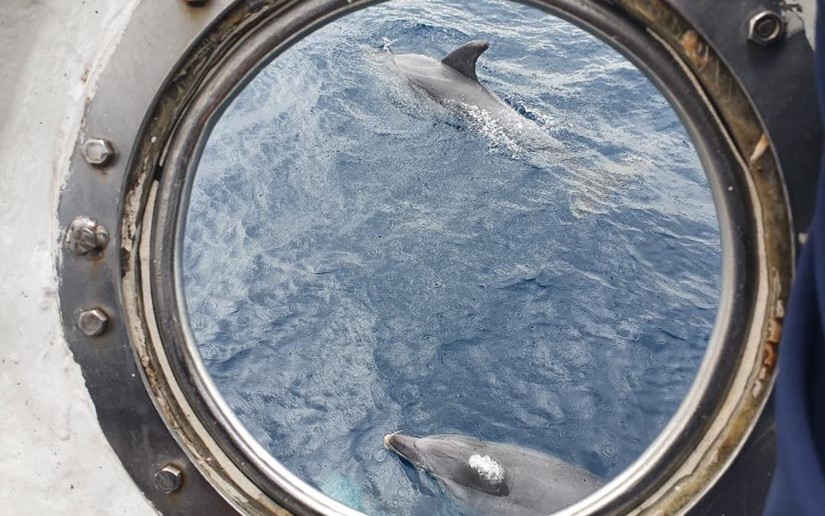
Day 8, 2nd September 2022. Migration observatories: Algarrobo & Cazalla and La Janda
This day was spent visiting the migration observatories and unexplored parts of La Janda. We started in Huerta Grande where we added a good number of forest species, including Iberian Chiffchaff, and Common Firecrest, of which we got great views. We then went to Algarrobo Migration Observatory and spent some time enjoying raptor migration. We had an opportunity to watch close passing European Honey-buzzard and spent some time learning how to separate males from females as well as juveniles. With a wide variety of plumages, European Honey-Buzzard are a lot of fun to watch! There were other good raptors of course, including a good number of Egyptian Vulture, Short-toed Snake Eagle, Booted Eagle and Black Kite.
We then moved to Cazalla Migration Observatory, probably the most popular raptor migration watchpoint in Western Europe. Aside from the regular migrating raptors we were able to enjoy a juvenile Spanish Imperial Eagle in the scope. It was another good migration session in the Strait of Gibraltar.
We had our picnic lunch in a pine forest near La Janda and took a walk with a main target in mind, the Iberian Green Woodpecker. It took some time but after some persistence, we got several views of a flying bird coming and going a certain area. Here we also had good views of Eurasian Hoopoe and Spotted Flycatcher.
In the afternoon we went to the main canal at La Janda. It was rather slow at La Janda, but even so we had a good time seeing some birds we had seen before. The standout was a big flock of more than one thousand Spanish Sparrow, which we could see from the vehicle and pay attention to the features that differentiate them from House Sparrow, which were also present. It was a good way to end our last day in the Strait of Gibraltar before driving up to the Ronda Mountains.
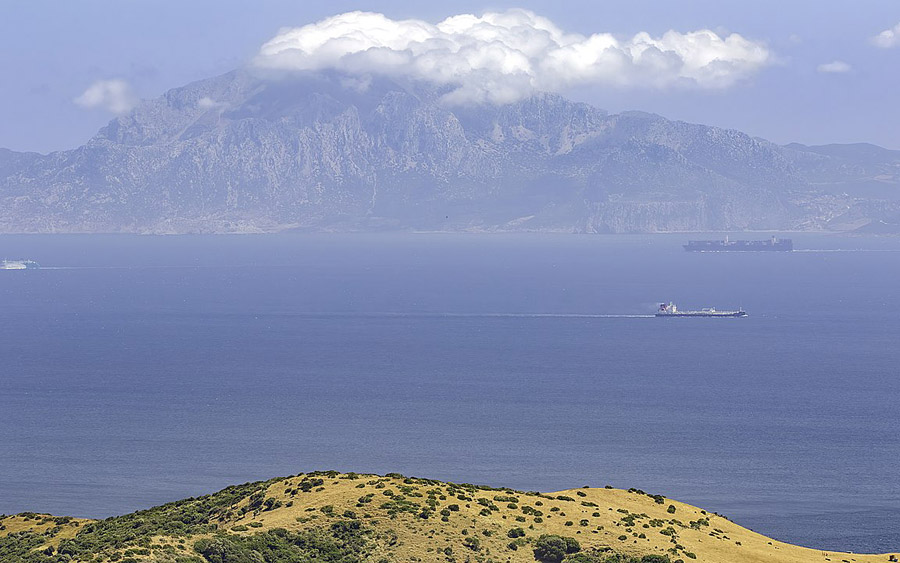
Day 9, 3rd September 2022. Alcornocales Natural Park and drive to Ronda
We left our hotel in Tarifa after a very pleasant stay and headed north towards Ronda. We took a nice detour to explore some of the nicest locations in Los Alcornocales Nature Reserve, one of the largest natural parks in Spain. Right at the gate of the reserve we had a flying Eurasian Golden Oriole. We stopped and looked for it to get better views and after a couple of minutes this beautiful bird flew right above us.
Once inside the reserve, the scenery gradually changed until we were in a fantastic patch of Cork and Algerian Oak. Here not only did we get to see some nice forest birds, but we had some good migration above as well. In the forest we had Eurasian Jay, European Crested Tit, Short-toed Treecreeper, and Western Bonelli’s Warbler, among others. Overhead, up to eight Black Stork were seen together with more raptors, including Egyptian Vulture, Western Marsh Harrier, and Common Buzzard.
We had a picnic lunch in a nice recreational area of the natural park, where we added Eurasian Nuthatch to our list. The rest of the afternoon was mainly spent doing a scenic drive up to the Ronda Mountains, with several stops at different lookouts to enjoy the view of the famous “Pueblos Blancos” (White Villages) in the province of Malaga. At the end of the day, we checked into our fantastic hotel in a great spot in the Ronda Mountains.
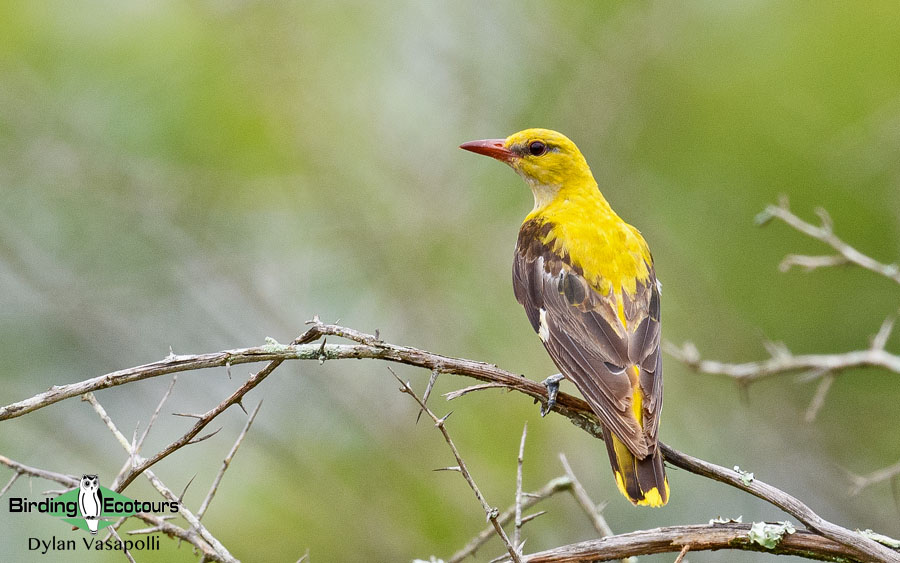
Day 10, 4th September 2022. Llanos de Libar and Ronda
On our last full day of the tour, we had the opportunity to explore a completely different environment, the limestone outcrops of the Ronda Mountains inside Grazalema Nature Reserve.
We started close to our accommodation, in “El Hundidero”, where we took a short walk and had great views of Great Spotted Woodpecker and Alpine Swift, as well as our first Black Wheatear of the trip. Next we headed to Llanos de Libar, not far from the charming town of Montejaque, where we spent most of our day. There was a fantastic dirt track that allowed us to bird at leisure, frequently stopping the vehicle and walking for short distances.
The first highlight was a close encounter with a group of Iberian Ibex. They spectacularly climbed some steep slopes, and we enjoyed fantastic views of these curious-looking animals. A bit later we saw Black Wheatear exceptionally well and enjoyed a close flight of a Eurasian Sparrowhawk that was roosting near the road. A small patch of bushes held Western Subalpine Warbler together with at least three Dartford Warbler and one Greater Whitethroat. Other nice birds here were Rock Bunting and Cirl Bunting. Surprisingly, this was also the first occasion where we found Eurasian Wren!
After a nice picnic lunch in the shade, we continued our drive up on the dirt track to reach a nice patch of Holm Oak. Here we had good views of forest birds, particularly in a certain spot where there was water, and the birds were coming down to bathe and drink. Species seen here included European Bee-eater, Great Spotted Woodpecker, Eurasian Jay, Willow Warbler, Western Subalpine Warbler, Rock Bunting, and Cirl Bunting. However, some of the best birds were on the farmland surrounding the forest, including Iberian Grey Shrike, Western Black-eared Wheatear, Northern Wheatear, Whinchat, and Rock Sparrow. A great selection of birds to add to our list!
We drove back to our accommodation for a break, a dip in the pool for some, and got ready for a short drive to the lovely town of Ronda. Here we took a walk along the famous Tajo de Ronda, with phenomenal views of the surrounding peaks. We had a playful flock of Red-billed Chough entertaining us through the walk and all the way to the restaurant, where we had our last dinner of the tour with splendid views to the setting sun against the mountains.
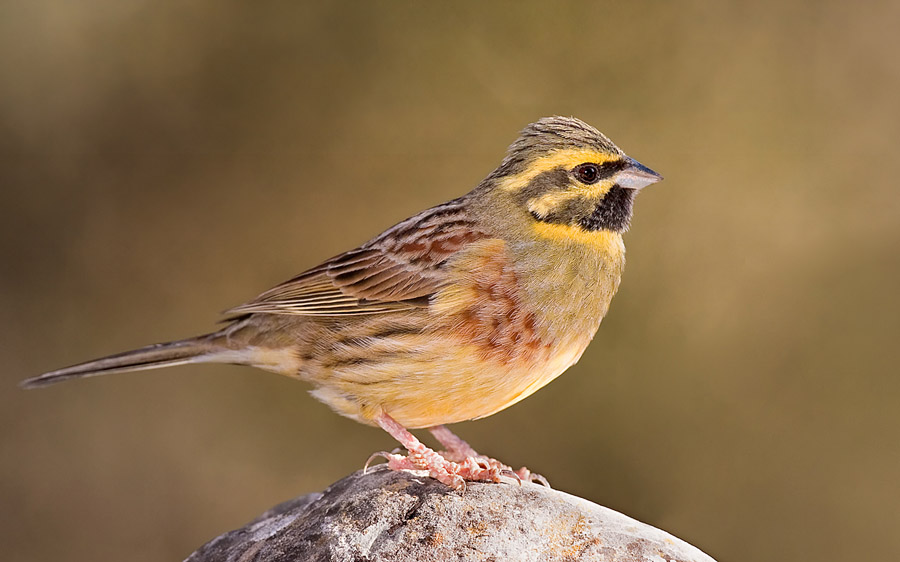
Day 11, 5th September 2022. Drive to Málaga
We started our drive back to Malaga and made a final stop amongst some cliffs along the way, hoping to catch a view of Bonelli’s Eagle. We unfortunately struck out on this species but added, unexpectedly, Great Crested Grebe in a nearby reservoir and enjoyed a nice flying Osprey.
We reached the city of Malaga where we offloaded all participants at their respective hotels and said our goodbyes. All in all, this was a successful trip which focused on the raptor migration in the Strait of Gibraltar, but also offered much more, being a nice, extended view of what southern Spain has to offer in the fall.
Bird List – Following IOC (12.1)
The following notation after species names is used to show conservation status following BirdLife International: CR= Critically Endangered, EN= Endangered, VU = Vulnerable, NT = Near Threatened
|
Common Name |
Scientific Name |
|
Ducks, Geese, Swans (Anatidae) |
|
|
Northern Shoveler |
Spatula clypeata |
|
Mallard |
Anas platyrhynchos |
|
Marbled Duck – VU |
Marmaronetta angustirostris |
|
Common Pochard – VU |
Aythya ferina |
|
Tufted Duck |
Aythya fuligula |
|
White-headed Duck – EN |
Oxyura leucocephala |
|
Pheasants & Allies (Phasianidae) |
|
|
Ring-necked Pheasant |
Phasianus colchicus |
|
Red-legged Partridge |
Alectoris rufa |
|
|
|
|
Nightjars (Caprimulgidae) |
|
|
Red-necked Nightjar |
Caprimulgus ruficollis |
|
Swifts (Apodidae) |
|
|
Alpine Swift |
Apus melba |
|
Common Swift |
Apus apus |
|
Pallid Swift |
Apus pallidus |
|
Little Swift |
Apus affinis |
|
|
|
|
Pigeons, Doves (Columbidae) |
|
|
Rock Dove |
Columba livia |
|
Common Wood Pigeon |
Columba palumbus |
|
European Turtle Dove |
Streptopelia turtur |
|
Eurasian Collared Dove |
Streptopelia decaocto |
|
Laughing Dove |
Spilopelia senegalensis |
|
Rails, Crakes & Coots (Rallidae) |
|
|
Common Moorhen |
Gallinula chloropus |
|
Eurasian Coot |
Fulica atra |
|
Red-knobbed Coot |
Fulice cristata |
|
Western Swamphen |
Porphyrio porphyrio |
|
Grebes (Podicipedidae) |
|
|
Little Grebe |
Tachybaptus ruficollis |
|
Great Crested Grebe |
Podiceps cristatus |
|
|
|
|
Flamingos (Phoenicopteridae) |
|
|
Greater Flamingo |
Phoenicopterus roseus |
|
Stone-curlews, Thick-knees (Burhinidae) |
|
|
Eurasian Stone-curlew |
Burhinus oedicnemus |
|
Stilts, Avocets (Recurvirostridae) |
|
|
Black-winged Stilt |
Himantopus himantopus |
|
Pied Avocet |
Recurvirostra avosetta |
|
Oystercatchers (Haematopodidae) |
|
|
Eurasian Oystercatcher |
Haematopus ostralegus |
|
Plovers (Charadriidae) |
|
|
Grey Plover |
Pluvialis squatarola |
|
Northern Lapwing |
Vanellus vanellus |
|
Common Ringed Plover |
Charadrius hiaticula |
|
Little Ringed Plover |
Charadrius dubius |
|
Kentish Plover |
Charadrius alexandrinus |
|
Sandpipers, Snipes (Scolopacidae) |
|
|
Eurasian Whimbrel |
Numenius phaeopus |
|
Eurasian Curlew |
Numenius arquata |
|
Bar-tailed Godwit |
Limosa lapponica |
|
Black-tailed Godwit |
Limosa limosa |
|
Ruddy Turnstone |
Arenaria interpres |
|
Ruff |
Calidris pugnax |
|
Curlew Sandpiper |
Calidris ferruginea |
|
Temminck’s Stint |
Calidris temminckii |
|
Sanderling |
Calidris alba |
|
Dunlin |
Calidris alpina |
|
Little Stint |
Calidris minuta |
|
Common Snipe |
Gallinago gallinago |
|
Common Sandpiper |
Actitis hypoleucos |
|
Green Sandpiper |
Tringa ochropus |
|
Common Redshank |
Tringa totanus |
|
Wood Sandpiper |
Tringa glareola |
|
Common Greenshank |
Tringa nebularia |
|
Coursers, Pratincoles (Glareolidae) |
|
|
Collared Pratincole |
Glareola pratincola |
|
|
|
|
Gulls, Terns, Skimmers (Laridae) |
|
|
Slender-billed Gull |
Chroicocephalus genei |
|
Black-headed Gull |
Chroicocephalus ridibundus |
|
Audouin’s Gull – VU |
Ichthyaetus audouinii |
|
Mediterranean Gull |
Ichthyaetus melanocephalus |
|
Yellow-legged Gull |
Larus michahellis |
|
Lesser Black-backed Gull |
Larus fuscus |
|
Gull-billed Tern |
Gelochelidon nilotica |
|
Caspian Tern |
Hydroprogne caspia |
|
Sandwich Tern |
Thalasseus sandvicensis |
|
Little Tern |
Sternula albifrons |
|
Common Tern |
Sterna hirundo |
|
Whiskered Tern |
Chlidonias hybrida |
|
Black Tern |
Chlidonias niger |
|
Skuas (Stercorariidae) |
|
|
Great Skua |
Stercorarius skua |
|
Pomarine Jaeger (Pomarine Skua) |
Stercorarius pomarinus |
|
Parasitic Jaeger (Arctic Skua) |
Stercorarius parasiticus |
|
|
|
|
Petrels, Shearwaters, Diving Petrels (Procellariidae) |
|
|
Cory’s Shearwater |
Calonectris borealis |
|
Scopoli’s Shearwater |
Calonectris diomedea |
|
Manx Shearwater |
Puffinus puffinus |
|
Balearic Shearwater – CR |
Puffinus mauretanicus |
|
Storks (Ciconiidae) |
|
|
Black Stork |
Ciconia nigra |
|
White Stork |
Ciconia ciconia |
|
|
|
|
Gannets, Boobies (Sulidae) |
|
|
Northern Gannet |
Morus bassanus |
|
Cormorants, Shags (Phalacrocoracidae) |
|
|
Great Cormorant |
Phalacrocorax carbo |
|
Ibises, Spoonbills (Threskiornithidae) |
|
|
Glossy Ibis |
Plegadis falcinellus |
|
Northern Bald Ibis – EN |
Geronticus eremita |
|
Eurasian Spoonbill |
Platalea leucorodia |
|
|
|
|
Herons, Bitterns (Ardeidae) |
|
|
Black-crowned Night Heron |
Nycticorax nycticorax |
|
Squacco Heron |
Ardeola ralloides |
|
Western Cattle Egret |
Bubulcus ibis |
|
Grey Heron |
Ardea cinerea |
|
Purple Heron |
Ardea purpurea |
|
Great Egret |
Ardea alba |
|
Little Egret |
Egretta garzetta |
|
Ospreys (Pandionidae) |
|
|
Osprey |
Pandion haliaetus |
|
Kites, Hawks, Eagles (Accipitridae) |
|
|
Black-winged Kite |
Elanus caeruleus |
|
Egyptian Vulture |
Neophron percnopterus |
|
European Honey-buzzard |
Pernis apivorus |
|
Griffon Vulture |
Gyps fulvus |
|
Short-toed Snake Eagle |
Circaetus gallicus |
|
Booted Eagle |
Hieraaetus pennatus |
|
Spanish Imperial Eagle – VU |
Aquila adalberti |
|
Golden Eagle |
Aquila chrysaetos |
|
Benelli’s Eagle |
Aquila fasciata |
|
Eurasian Sparrowhawk |
Accipiter nisus |
|
Western Marsh Harrier |
Circus aeruginosus |
|
Montagu’s Harrier |
Circus pygargus |
|
Red Kite |
Milvus milvus |
|
Black Kite |
Milvus migrans |
|
Common Buzzard |
Buteo buteo |
|
Owls (Strigidae) |
|
|
Little Owl |
Athene noctua |
|
Hoopoes (Upupidae) |
|
|
Eurasian Hoopoe |
Upupa epops |
|
|
|
|
Rollers (Coraciidae) |
|
|
European Roller |
Coracias garrulus |
|
|
|
|
Kingfishers (Alcedinidae) |
|
|
Common Kingfisher |
Alcedo atthis |
|
|
|
|
Bee-eaters (Meropidae) |
|
|
European Bee-eater |
Merops apiaster |
|
|
|
|
Woodpeckers (Picidae) |
|
|
Great Spotted Woodpecker |
Dendrocopous major |
|
Iberian Green Woodpecker |
Picus sharpei |
|
Caracaras, Falcons (Falconidae) |
|
|
Lesser Kestrel |
Falco naumanni |
|
Common Kestrel |
Falco tinnunculus |
|
Lanner Falcon |
Falco biarmicus |
|
Peregrine Falcon |
Falco peregrinus |
|
|
|
|
African & New World Parrots (Psittacidae) |
|
|
Monk Parakeet |
Myiopsitta monachus |
|
Shrikes (Laniidae) |
|
|
Iberian Grey Shrike |
Lanius meridionalis |
|
Woodchat Shrike |
Lanius senator |
|
Figbirds, Orioles, Turnagra (Oriolidae) |
|
|
Eurasian Golden Oriole |
Oriolus oriolus |
|
Crows, Jays (Corvidae) |
|
|
Eurasian Jay |
Garrulus glandarius |
|
Eurasian Magpie |
Pica pica |
|
Red-billed Chough |
Pyrrhocorax pyrrhocorax |
|
Western Jackdaw |
Coloeus monedula |
|
Northern Raven |
Corvus corax |
|
Tits, Chickadees (Paridae) |
|
|
European Crested Tit |
Lophophanes cristatus |
|
Eurasian Blue Tit |
Cyanistes caeruleus |
|
Great Tit |
Parus major |
|
Penduline Tits (Remizidae) |
|
|
Eurasian Penduline Tit |
Remiz pendulinus |
|
Larks (Alaudidae) |
|
|
Thekla’s Lark |
Galerida theklae |
|
Crested Lark |
Galerida cristata |
|
Greater Short-toed Lark |
Calandrella brachydactyla |
|
Calandra Lark |
Melanocorypha calandra |
|
Mediterranean Short-toed Lark |
Alaudala rufescens |
|
Swallows, Martins (Hirundinidae) |
|
|
Sand Martin |
Riparia riparia |
|
Eurasian Crag Martin |
Ptyonoprogne rupestris |
|
Barn Swallow |
Hirundo rustica |
|
Common House Martin |
Delichon urbicum |
|
Red-rumped Swallow |
Cecropis daurica |
|
Bulbuls (Pycnonotidae) |
|
|
Common Bulbul |
Pycnonotus barbatus |
|
Cettia Bush Warblers & Allies (Cettiidae) |
|
|
Cetti’s Warbler |
Cettia cetti |
|
|
|
|
Leaf Warblers & Allies (Phylloscopidae) |
|
|
Western Bonelli’s Warbler |
Phylloscopus bonelli |
|
Willow Warbler |
Phylloscopus trochilus |
|
Iberian Chiffchaff |
Phylloscopus ibericus |
|
|
|
|
Reed Warblers & Allies (Acrocephalidae) |
|
|
Eurasian Reed Warbler |
Acrocephalus scirpaceus |
|
Melodious Warbler |
Hippolais polyglotta |
|
|
|
|
Cisticolas & Allies (Cisticolidae) |
|
|
Zitting Cisticola |
Cisticola juncidis |
|
Sylviid Babblers (Sylviidae) |
|
|
Eurasian Blackcap |
Sylvia atricapilla |
|
Sardinian Warbler |
Curruca melanocephala |
|
Western Subalpine Warbler |
Curruca hortensis |
|
Common Whitethroat |
Curruca communis |
|
Dartford Warbler |
Curruca undata |
|
Goldcrests, Kinglets (Regulidae) |
|
|
Common Firecrest |
Regulus ignicapilla |
|
Wrens (Troglodytidae) |
|
|
Eurasian Wren |
Troglodytes troglodytes |
|
Nuthatches (Sittidae) |
|
|
Eurasian Nuthatch |
Sitta europaea |
|
Treecreepers (Certhiidae) |
|
|
Short-toed Treecreeper |
Certhia brachydactyla |
|
Starlings, Rhabdornis (Sturnidae) |
|
|
Spotless Starling |
Sturnus unicolor |
|
Thrushes (Turdidae) |
|
|
Common Blackbird |
Turdus merula |
|
Chats, Old World Flycatchers (Muscicapidae) |
|
|
Spotted Flycatcher |
Muscicapa striata |
|
Rufous-tailed Scrub-Robin |
Cercotrichas galactotes |
|
European Robin |
Erithacus rubecula |
|
Common Nightingale |
Luscinia megarhynchos |
|
European Pied Flycatcher |
Ficedula hypoleuca |
|
Black Redstart |
Phoenicurus ochruros |
|
Common Redstart |
Phoenicurus phoenicurus |
|
Blue Rock Thrush |
Monticola solitarius |
|
Whinchat |
Saxicola rubetra |
|
European Stonechat |
Saxicola rubicola |
|
Northern Wheatear |
Oenanthe oenanthe |
|
Western Black-eared Wheatear |
Oenanthe hispanica |
|
Black Wheatear |
Oenanthe leucura |
|
Dippers (Cinclidae) |
|
|
White-throated Dipper |
Cinclus cinclus |
|
Old World Sparrows, Snowfinches (Passeridae) |
|
|
Rock Sparrow |
Petronia petronia |
|
Spanish Sparrow |
Passer hispaniolensis |
|
House Sparrow |
Passer domesticus |
|
|
|
|
Weavers, Widowbirds (Ploceidae) |
|
|
Black-headed Weaver |
Ploceus melanocephalus |
|
Yellow-crowned Bishop |
Euplectes afer |
|
|
|
|
Waxbills, Munias & Allies (Estrildidae) |
|
|
Common Waxbill |
Estrilda astrild |
|
Wagtails, Pipits (Motacillidae) |
|
|
Western Yellow Wagtail |
Motacilla flava |
|
Tawny Pipit |
Anthus campestris |
|
|
|
|
Finches, Euphonias (Fringillidae) |
|
|
Common Chaffinch |
Fringilla coelebs |
|
European Greenfinch |
Chloris chloris |
|
Common Linnet |
Linaria cannabina |
|
European Goldfinch |
Carduelis carduelis |
|
European Serin |
Serinus serinus |
|
Buntings (Emberizidae) |
|
|
Corn Bunting |
Emberiza calandra |
|
Rock Bunting |
Emberiza cia |
|
Cirl Bunting |
Emberiza cirlus |
|
Total recorded |
184 |
Mammal List
|
Common Name |
Scientific Name |
|
Rabbits and Hares (Leporidae) |
|
|
European Rabbit |
Oryctolagus cuniculus |
|
|
|
|
Bovids (Bovidae) |
|
|
Iberian Ibex |
Capra pyrenaica |
|
|
|
|
Deer (Cervidae) |
|
|
Fallow Deer |
Dama dama |
|
|
|
|
Oceanic Dolphins (Delphinidae) |
|
|
Long-finned Pilot Whale |
Globicephala melas |
|
Common Bottlenose Dolphin |
Tursiops truncatus |
|
|
|
|
Sperm Whales (Physeteridae) |
|
|
Sperm Whale |
Physeter macrocephalus |
|
Total |
6 |
Reptile List
|
Common Name |
Scientific Name |
|
Colubrid Snakes (Colubridae) |
|
|
Horseshoe Whip Snake |
Hemorrhois hippocrepis |
|
|
|
|
Pond Turtles (Emydidae) |
|
|
Spanish Pond Turtle |
Mauremys leprosa |
|
Total |
2 |
Fish List
|
Common Name |
Scientific Name |
|
Atlantic Bluefin Tuna |
Thunnus thynnus |
|
Ocean Sunfish |
Mola mola |
|
Total |
2 |
DOWNLOAD TRIP REPORT
This is a sample trip report. Please email us ([email protected]) for more trip reports from this destination.
